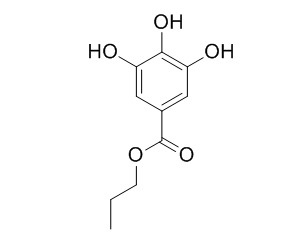Propyl gallate
Propyl gallate shows antioxidant,and hepatoprotective activities, it can potently inhibit diphenolase activity of tyrosinase. Propyl gallate inhibits the growth of HeLa cells via regulating intracellular GSH level,it also shows inhibitory effects on selected food-borne bacteria.
Inquire / Order:
manager@chemfaces.com
Technical Inquiries:
service@chemfaces.com
Tel:
+86-27-84237783
Fax:
+86-27-84254680
Address:
1 Building, No. 83, CheCheng Rd., Wuhan Economic and Technological Development Zone, Wuhan, Hubei 430056, PRC
Providing storage is as stated on the product vial and the vial is kept tightly sealed, the product can be stored for up to
24 months(2-8C).
Wherever possible, you should prepare and use solutions on the same day. However, if you need to make up stock solutions in advance, we recommend that you store the solution as aliquots in tightly sealed vials at -20C. Generally, these will be useable for up to two weeks. Before use, and prior to opening the vial we recommend that you allow your product to equilibrate to room temperature for at least 1 hour.
Need more advice on solubility, usage and handling? Please email to: service@chemfaces.com
The packaging of the product may have turned upside down during transportation, resulting in the natural compounds adhering to the neck or cap of the vial. take the vial out of its packaging and gently shake to let the compounds fall to the bottom of the vial. for liquid products, centrifuge at 200-500 RPM to gather the liquid at the bottom of the vial. try to avoid loss or contamination during handling.
Asian J Beauty Cosmetol2021, 19(1): 57-64.
Sci Rep.2017, 7:467-479
Biomed Pharmacother.2024, 179:117365.
J Microbiol Biotechnol.2024, 35:e2408022.
Front Pharmacol.2021, 12:744624.
Toxicol In Vitro.2022, 81:105346.
Chem Biol Interact.2022, 368:110248.
Heliyon2020, 6(6):e04337.
Phytomedicine Plus2022, 2(1):100207.
Patanjali Research Foundation2024, ssrn.4807357
Related and Featured Products
Letters in Applied Microbiology, 1993, 17(1):29-32.
Growth-Inhibition of Selected Food-Borne Bacteria by Tannic-Acid, Propyl Gallate and Related-Compounds[Reference:
WebLink]
METHODS AND RESULTS:
Tannic acid, Propyl gallate, gallic acid and ellagic acid were tested for their inhibitory effects on selected food-borne bacteria by the well assay technique.
CONCLUSIONS:
Tannic acid and Propyl gallate were inhibitory whereas gallic acid and ellagic acid were not.
J Agric Food Chem. 2003 Feb 12;51(4):1077-80.
Sequestering ability of butylated hydroxytoluene, propyl gallate, resveratrol, and vitamins C and E against ABTS, DPPH, and hydroxyl free radicals in chemical and biological systems.[Pubmed:
12568575 ]
The antioxidant capacity of butylated hydroxytoluene (BHT; 2,6-di-tert-butyl-p-cresol), Propyl gallate (3,4,5-trihydroxybenzoic acid n-propyl ester), resveratrol (trans-3,4',5-trihydroxystilbene), and vitamins C (l-ascorbic acid) and E [(+)-alpha-tocopherol] was studied in chemical and biological systems.
METHODS AND RESULTS:
The chemical assays evaluated the capacity of these antioxidants to sequester 2,2'-azinobis(3-ethylbenzthiazoline-6-sulfonic acid) (ABTS.) and 1,1 diphenyl-2-picrylhydrazyl (DPPH.). A new colorimetric method to determine hydroxyl radical scavenging is also described. The biological tests use the eucaryotic cells of Saccharomyces cerevisiae treated with the antioxidants in the presence of the stressing agents apomorphine, hydrogen peroxide, and paraquat dichloride (methylviologen; 1,1'-dimethyl-4,4'-bipyridinium dichloride).
The results in chemical systems showed that all of the antioxidants were able to significantly inhibit the oxidation of beta-carotene by hydroxyl free radicals.
The assays in yeast showed that the antioxidant activity of the tested compounds depended on the stressing agent used and the mechanism of action of the antioxidant.
Biochemical Pharmacology, 1994, 48(2):419-422.
Propyl gallate as a hepatoprotector in vitro and in vivo.[Pubmed:
8053938]
Recently, there has been renewed interest in Propyl gallate, a preservative in foods and fuels. This compound, which exhibits antimicrobial activity, has been found to be toxicologically safe after almost 30 years of evaluation.
METHODS AND RESULTS:
In the present study, we examined whether Propyl gallate is a hepatoprotective antioxidant, and investigated some of its bases of action vis-à-vis Trolox, a vitamin E analogue. In isolated rat hepatocytes, Propyl gallate prolonged substantially cell survival against oxyradicals generated with xanthine oxidase-hypoxanthine. The protection was dose dependent and excelled that of Trolox, mannitol, or ascorbate, each at or near its optimum level in the same system. In rats undergoing an 80-min partial hepatic ischemia, infusion of Propyl gallate at 20 mumol/kg body weight just before a 24-hr reperfusion salvaged the organ by 80.0 +/- 11.5%, an extent comparable to that with Trolox. Mechanistically, we found that Propyl gallate (a) protected hepatocytes against the cascade of oxyradicals produced by xanthine oxidase-hypoxanthine; (b) protected hepatocytes against superoxide radicals generated specifically by menadione; (c) protected the functionally important hepatic vascular endothelial cells more effectively than Trolox against xanthine oxidase-hypoxanthine, and (d) approximately halved the amount of lipid conjugated dienes (a more specific marker of oxyradical damage than malondialdehyde) formed in tissues after oxidant damage.
CONCLUSIONS:
Therefore, there are fundamental reasons why Propyl gallate is an effective antioxidant-based hepatoprotector, both in vitro and in vivo.
Food Chem Toxicol. 2009 Oct;47(10):2531-8.
Propyl gallate inhibits the growth of HeLa cells via regulating intracellular GSH level.[Pubmed:
19622380]
Propyl gallate (PG) as a synthetic antioxidant exerts a variety of effects on tissue and cells.
METHODS AND RESULTS:
Here, we investigated an involvement of glutathione (GSH) and reactive oxygen species (ROS) in PG-induced inhibition of HeLa cell growth. PG dose-dependently inhibited HeLa cell growth and induced apoptosis at 24h. The intracellular ROS levels including O(2)(-) were increased or decreased in PG-treated HeLa cells depending on the incubation times (1 or 24h) and doses (100-1600 microM). PG increased activities of superoxide dismutase (SOD) and catalase in HeLa cells. PG significantly increased GSH depleted cells in a time- and dose-dependent manner. Treatment with 2 mM N-acetyl-cysteine (NAC; a well known antioxidant) slightly prevented 400 microM PG-induced cell death, which was accompanied by an increase in ROS level and a decrease in GSH depletion level. PG induced a G1 phase arrest of the cell cycle. NAC did not affect the cell cycle distributions in PG treated- or untreated-HeLa cells. Conclusively, PG inhibited the growth of HeLa cells via regulating GSH level rather than ROS level.
CONCLUSIONS:
Our present data could provide useful information on the molecular anti-growth mechanisms of PG in cancer cells in relation to ROS and GSH level.



